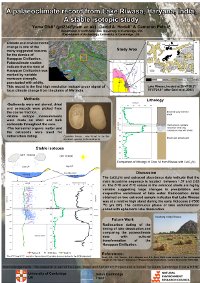| Authors | Yama Dixit, David Hodell |
| Title | A Climate Record from Riwasa Lake, Haryana, India; The Results of Carbon and Oxygen Stable Isotope Analysis |
Abstract
The Harappan Civilisation lourished from ~3900 to ~4600 yrs BP in the arid region straddling the border of present-day India and Pakistan. The rols of climate and environmental change in the demise of this urban civilisation is at present unclear. Paleoclimate proxy studies suggest that the time of Harappan Civilisation was a period of declining monsoon strength, punctuated by episodes of aridity. However, there is only limited physical evidence from the plains of NW India for past environmental conditions. Hence, we have used sediment cores drilled from paleo-Lake Riwasa to reconstruct the local paleoclimate history and assess possible links with cultural transformations.
Riwasa is a dry lake bedthat lies in the semi arid zone at the NE edge of the Thar Desert where the rainfall gradient is steep and therefore the lake’s hydrology is sensitive to past changes in the balance of regional precipitation and evaporation. The sediment lithology consists of a lacustrine carbonate sequence of close to 3metres, which is interbedded with aeolian sand units. The lacustrine sediment contains abundant biogenic carbonates including freshwater gastropods and ostracods (dominated by Cyprideis torosa ). Sediment samples were wet sieved; dried and gastropods and ostracods specimens have been hand picked for stable isotope analysis. Oxygen isotope variations are interpreted in terms of changing input related to the monsoon intensity and the ratio of lake evaporation to precipitation (E/P). Radiocarbon dating of terrestrial organic matter (wood, roots and seeds) and shell provide chronological control. The Riwasa record constitutes the first isotope proxy signal of local palaeoclimate change for the Holocene obtained for the plains of NW India.
